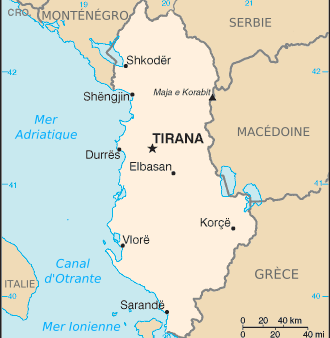Europe > Albania: Weather, Map, Costs and Travel Guide

Albania : When and where to go?
Click on a city for complete climate and weather tables
Albania: Climate & Weather
The climate is decidedly Mediterranean throughout the whole of the coastal area with hot summers tending towards heat waves. Winters are rainy but mild in temperature with very agreeable mid-seasons.
It tends to be more continental in the mountainous zones: The temperature differences are especially marked from one season to another and the north-east of the country experiences harsh winters with frequent snow. The best times to visit Albania are the months of May, June and September.
Weather today

Clear
Wind: 3 km/h
Precipitation forecast: 0 mm
> Full report and 7-days forecast
Data updated at 09:53 (local time)
At that time, the weather was:
 9 °C / Clear
9 °C / Clear
Albania: Map

Sponsored links
What to do in Albania
The Capital, Tirana, with its colourfully painted buildings, merits a prolonged visit, especially the Skanderberg Place, around the Ethem Bey Mosque and the National History Museum.
More to the north, at Krujë, you can visit the Skanderberg Museum or the Ethnographical Museum. A stroll around the bazaar will capture you with its picturesque atmosphere.
To the east, Korçë possesses an excellent Medieval Art Museum or you could visit the Cathedral and there is also a 500 year old Mosque that is definitely worth a visit. The surrounding area has various old orthodox churches decorated with magnificent frescoes.
Gjirokastër, in the centre of the country, has been designated as a World Heritage site by UNESCO due to its medieval houses with (flagstone) roofs, its cobbled streets and the 11th Century castle. There is also a weapons museum and an ethnographical museum. Close by, the town of Berat is another popular destination due to its white houses, its castle, Byzantine churches and the Onufri Museum.
On the southern coast you will discover creeks and cliffs, with beaches in between that are for the most part deserted. Visit the Greek city of Apollonia, the Ardenica Monastery, the villages of Vunoi and Himara and of course Butrint, the old Greco-Roman city with its acropolis, theatre, baptistery mosaics and its fortifications.
Albania: The basics
You do not need a visa if you are coming from a country within the European Union.
The currency used is the lek.
You will not need to plan for a large budget: A reasonable double room will cost less than €50 and you can eat well for €5.
Concerning health, avoid drinking tap water and watch out for gastro-enteritis which occurs frequently.
Note: Water cuts and electricity blackouts are fairly frequent and can disturb your daily comfort.
Be careful in the southern areas, they are susceptible to seismic disturbances.
If you travel in the country’s interior, the bus is the best form of transport even if they are irregular and a little uncomfortable. Renting a car (preferably a 4 wheel drive) is obviously the best solution although the state of the roads is often bad, sometimes awful.







